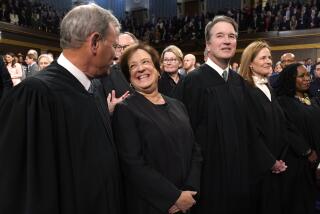Brennan Leaves Legacy of Land-Use Opinions : Law: Growth controls in the Southland are likely to trigger legal challenges deeply rooted in rulings by the former Supreme Court Justice.
For the first time in more than three decades, the U.S. Supreme Court begins a new term this week without Justice William J. Brennan Jr. No judge in this century has had a greater impact on real estate law and the shape of our cities and suburbs.
For California, Justice Brennanâs retirement is a special loss. In their excellent book, âLandmark Justice,â Harvard Law School professor Charles M. Haar and Jerold S. Kayden note that California has been âthe preeminent state battleground between development and environmental interests.â Five of the six major recent U.S. Supreme Court land-use cases arose from California disputes.
Brennanâs imprint will last long beyond his tenure on the court. In an important San Diego case, he established a cornerstone of modern land-use law--that local governments must pay just compensation when regulations deny owners a reasonable economic use of their property.
Southern California growth controls and exactions are likely to trigger legal challenges deeply rooted in Justice Brennanâs opinions. The San Diego case and an earlier Brennan land-use decision provide the benchmarks against which judges will evaluate such challenges.
Brennanâs most famous land-use opinion was a New York case, the 1978 Penn Central decision.
This decision, sustaining historic preservation for New York Cityâs Grand Central Terminal, was crucial not only for that building but for historic structures and districts throughout California and other states.
At the time the Supreme Court decided Penn Central, California and every other state, and more than 500 municipalities, had enacted laws to encourage or require the preservation of buildings and areas with historic importance.
In Penn Central, a developer sought to build a skyscraper above the existing terminal. The New York Landmarks Preservation Commission had rejected the proposal because of its impact on the historic Grand Central Terminal.
Instead of submitting alternative plans to the commission, the developer filed suit, claiming that the Landmarks Commission had âtakenâ its property without just compensation by significantly diminishing the value of the site.
The Supreme Court upheld both the law and its application to Grand Central, providing a compelling precedent to support local laws such as those in Los Angeles and other California cities.
Brennan pointed to the growing recognition that too many historic structures had been destroyed without adequate consideration of either the values they represented or the possibility of preserving them in economically productive ways.
Moreover, Brennan observed, structures with special historical or architectural significance enhance the quality of life for all.
âNot only do these buildings in their workmanship represent the lessons of the past and embody precious features of our heritage, they serve as examples of quality for today,â he wrote.
Finally, Brennan emphasized that the developer was earning a âreasonable returnâ on its investment in the existing terminal. Brennan also noted that New York law permitted the developer to transfer development rights from on top of the terminal to nearby parcels, thus mitigating financial burdens under the landmark designation.
Brennan recognized in the Penn Central decision that some local government regulations can go too far, setting the stage for his second major land-use opinion protecting the rights of property owners from overreaching land-use controls.
In the 1981 case of San Diego Gas & Electric Co. v. City of San Diego, the city had downzoned to agricultural use some of the utilityâs land north of Torrey Pines State Park that previously could have been used for a nuclear power plant.
The city designated the land as open space in a new plan, tagging the parcel for public acquisition but never raising the money to buy the property. The utility claimed these actions amounted to a âtakingâ of the property that required just compensation.
A majority on the Supreme Court never reached the merits of the case for technical reasons, but Justice Brennan was prepared to do so in his dissent.
Brennan reasoned that if a regulation goes too far and becomes a taking, then the property owner is entitled to just compensation for the period of time the regulation effected the taking. In 1987, the Supreme Court formally endorsed Brennanâs position.
The San Diego dissent opened a new door to damage suits by property owners against local and state governments. Payment of just compensation represents a substantially greater threat to municipalities than mere invalidation of an ordinance, which had been the remedy in California and a number of other states.
City planners feared that making local governments liable to pay for regulatory takings would inhibit sound local planning actions. Brennan responded pointedly, âIf a policeman must know the Constitution, then why not a planner?â
Besides these two path-breaking opinions, Brennan wrote 20 other land-use opinions while a judge in New Jersey and on the U.S. Supreme Court.
In their study of Justice Brennanâs land-use opinions, Haar and Kayden write that Brennan âis unequalled for the many legal opinions he has written having profound implications for land use in the United States.â
They predict that either Justice Scalia or Justice Stevens is most likely to assume the mantle of the judge most active in the land-use area, with Scalia favoring private property rights and Stevens defending government actions.
In real estate, as in other areas of the law, Brennan interpreted the Constitution to make it more responsive to the needs of the people whom it was intended to protect. His judicial legacy will provide lasting benefits for cities and developers.
Zax is a partner in the law firm of Fried, Frank, Harris, Shriver & Jacobson and head of the real estate department in the firmâs Washington office. His book on âDoing Deals With the RTCâ will be published by the Urban Land Institute later this year.
READER IDEAS FOR SPEAKING OUT
Readers wishing to express their views on topics of interest should send queries or manuscripts to Real Estate Editor, Los Angeles Times, Times Mirror Square, Los Angeles, 90053.
More to Read
Inside the business of entertainment
The Wide Shot brings you news, analysis and insights on everything from streaming wars to production â and what it all means for the future.
You may occasionally receive promotional content from the Los Angeles Times.










